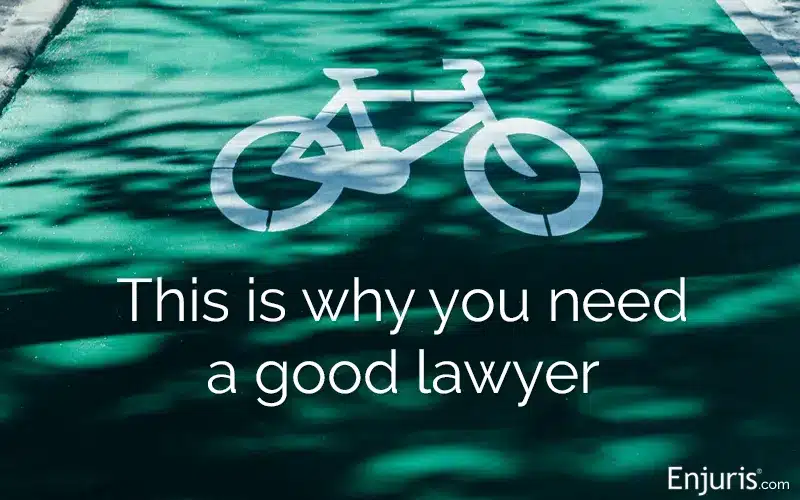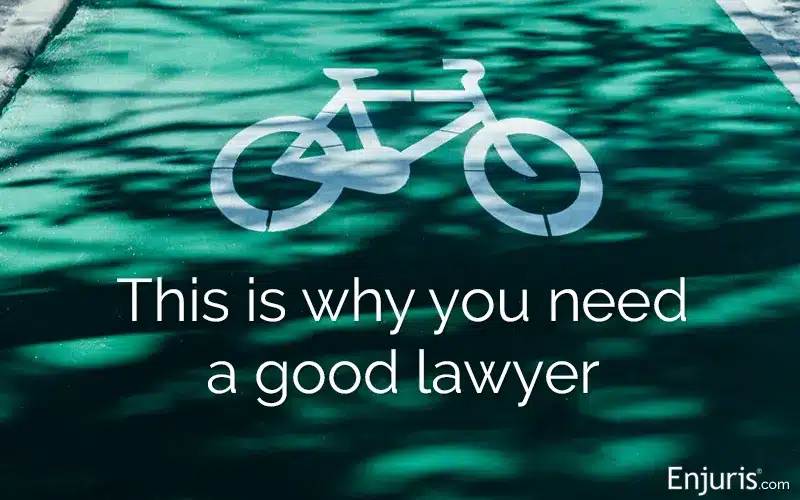[ad_1]

Legal strategy nets $1.6 million verdict
Sometimes, the most obvious solution is not the best one. This plaintiff’s lawyers found a way to maximize his compensation by taking an alternate approach to legal strategy.
If you’ve been in a collision, you might have searched for information online and found pages and pages of legal advice for people who’ve been in car accidents or bicyclists who’ve been hit by a car. But it’s more unusual to see a lawsuit among two bicyclists who collided with each other.
The key to receiving compensation as the victim of a personal injury accident is determining who was liable for the injuries. The purpose of the personal injury legal system is to make a victim “whole”, or to restore them to the financial condition they would be in if the accident never happened.
How insurance is used in an accident
The way this normally plays out is that the person who caused the injury is financially responsible for paying for the victim’s medical treatment and related expenses. For instance, we’d assume that an at-fault driver is responsible for costs of a car crash. When that happens, the victim would typically make a claim against the at-fault driver’s auto insurance policy and the insurance company pays the victim’s expenses.
Some states follow a no-fault system in which each driver would would turn first to their own insurance for coverage. They would only recover damages from the at-fault driver after exhausting their own policy maximum. In a no-fault state, they usually have what’s called a tort liability threshold, which means the driver could sue for severe injuries under certain conditions.
Some no-fault states have Personal Injury Protection (PIP) insurance. The purpose of PIP is to provide coverage to a driver right away so they have time to determine who was at fault for the crash. Usually, a driver’s PIP insurance applies to themself (i.e the insured policyholder) and their passengers. In the event of an accident with a pedestrian or bicyclist, the insured’s PIP policy would extend to the injured person.
However, all of this is assuming that the parties have automotive insurance. What happens if two bicyclists collide and they are not covered under an automotive insurance policy? Who pays?
This is the question that had to be answered when two cyclists collided in an Atlanta bike lane. Using a unique legal strategy, jurors awarded $1.6 million based on the plaintiff’s lawyer’s argument.
They chose to target the defendant’s homeowner’s insurance policy rather than the auto insurance policy to allow the plaintiff to receive damages.
The bicycle accident
In March 2021, Sean McGaha was riding in the bicycle lane on 10th Street in Atlanta. Robert Peek was riding the opposite direction in a lane designated for motorized vehicles. Peek merged into McGaha’s lane and the two collided, resulting in McGaha’s serious injuries. McGaha flew off his bike and suffered severe injuries to his hands and wrists that required multiple surgeries. Peek was found to be liable for the collision.
What was the lawyers’ winning strategy?
The plaintiff’s lawyers focused on McGaha’s pain, rather than medical expenses. The victim’s medical bills were more than $160,000 but the lawyers took a “big risk” in deciding not to make that part of the demand.
After painstakingly combing the terms of the defendant’s automotive and homeowners insurance policies, McGaha’s lawyers offered to settle the complaint for $1.2 million, but the defendant declined. The defendant offered $430,000 but the plaintiff said that wasn’t enough. They suspected that the defendant’s insurer, State Farm Insurance, would be unlikely to pay more than $500,000.
Therefore, the plaintiff’s lawyers shifted gears away from focusing on his hand and wrist injuries and instead drew attention to the amount he was owed for pain and suffering.
The plaintiff’s lawyers told the jury that the reason he was in court three years after the accident is because he was still feeling pain in his hands all that time later. He had lost the ability to do activities he loved, like cycling and water polo, along with other athletic pursuits.
After a three-day trial, the jury returned the verdict of a $1.6 million award for McGaha. As his lawyer said, “Jurors intuitively think that auto insurance protects defendants in motor vehicle accidents, but here we had a bicycle on bicycle. None of the jurors had the faintest idea that homeowners insurance was in play.”
The takeaway
What does this tell us about bicycle accidents and damage awards?
Of course, each lawsuit is unique. Even an accident that seems “cookie cutter” might have nuances that make it difficult to settle or litigate. But what this one shows us is that great lawyers will think outside the cookie-cutter approach to damages, and that creativity can be rewarded with success for their clients.
Don’t assume that a first settlement offer from a defendant or insurance company is necessarily the highest or best. On the contrary, often an insurance company will try to lowball you—the less they pay out, the higher their profit.
This is why you need a skilled, knowledgeable, experienced personal injury lawyer. They will explore every avenue to get you the compensation you need after your accident.
[ad_2]



